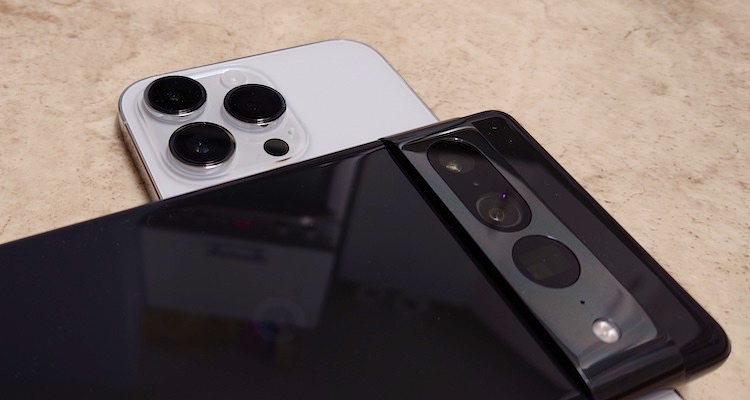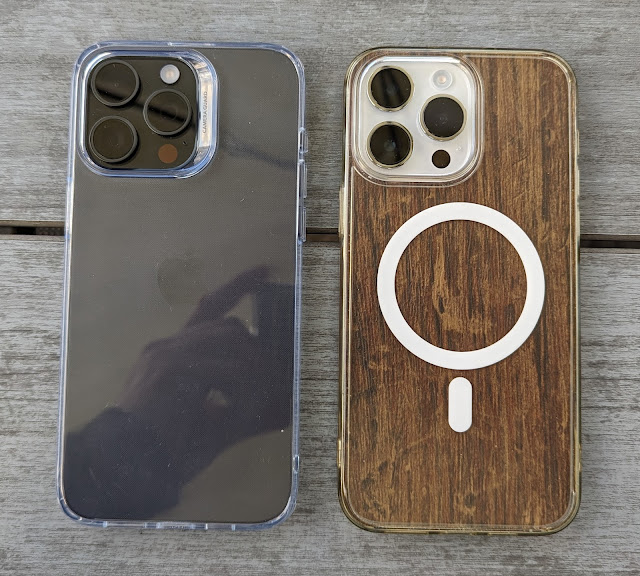Imaging showdown: Apple iPhone 14 Pro Max versus Google Pixel 7 Pro
Having already pitched the new iPhone against Sony's top contender, along comes Google lending me their new flagship, the Pixel 7 Pro, also boasting a lot of imaging smarts.
Again, on the iOS front, it's true that, by default, Apple also does a load of edge enhancement to iPhone 14 photos, but the Pro models (14 Pro Max here) let you toggle on ProRAW, a format that can be shared in the same way as regular cookie-cut JPGs (including for analysis here and download below) but which forgoes all the populist sharpening and enhancement, so you get the best of all worlds. You get the Deep Fusion and multi-frame combinations, all the software magic that makes modern flagship cameras work, but you don't get the 'nasty' last bit, the enhancement to make photos 'pop' on phone screens - the images are left alone, purer and more useable after the fact.
Google doesn't give quite the same capability - although you can turn on RAW in Camera's Settings, there's no easy way to share from these snaps - it's assumed that you'll use a dedicated editing application to do things to the RAW files, usually on a laptop or desktop. So on the Pixel I've stuck to the JPGs that Google outputs by default, packed with HDR and auto-contrast algorithms designed to give as much detail as possible.
As usual, I've avoided too many of what many other blogs major on - sunny day photos, since there's no point. When the sun's out almost any smartphone camera can pull off decent results. So I've concentrated either on zoom or on poorer, lower and artificial light conditions, enough to cause the phone cameras to pull out all the stops, as it were.
Notes:
- In each case I'm going to be looking at 1:1 central crops, matched for easy comparison, so that you can see what's going on at the pixel level.
- All 'scene' overviews were from the iPhone (just for consistency).
- See the link at the end of the article for all the original JPGs, should you wish to do your own analysis.
Test 1: Easy, peasy, sunny landscape
Nice and simple, let's get this out of the way. Here's the scene:
iPhone 14 Pro Max: 10 pts; Google Pixel 7 Pro: 10 pts
Test 2: Sunny landscape
One of my favourite test subjects, lit in weak winter sun in the UK. Here's the overall scene:
And here are central 1:1 crops from, in turn, the iPhone 14 Pro Max and Google Pixel 7 Pro:
It's a tough call to choose a winner unzoomed - the iPhone's shot looks more natural, while the Pixel's looks more 'digital' and processed, but its HDR routines are unmatched and the contrast and detail on the plane are fabulous. Honours even.
iPhone 14 Pro Max: 10 pts; Google Pixel 7 Pro: 10 pts
Test 3: Sunny landscape, zoomed x2
The same scene, but this time zoomed x2 in each Camera UI (both have presets for 2x). Here are central 1:1 crops from, in turn, the iPhone 14 Pro Max and Google Pixel 7 Pro:
We have, here, stumbled into one of the Pixel 7 Pro's few camera gotchas. Zooming digital on the main sensor is horrible. We'll see below that the telephoto image is spliced in neatly to the centre of the frame for shots slightly more zoomed in (actually anything over 2x), but at the UI preset of '2x', there's no splicing, no tricks. Just a fuzzy upscaling of the cropped Quad Bayer (so 3MP) output, i.e. not even at attempt to resample from the underlying 50MP image in some fashion. Very lazy, Google, and I'd hope that this would be sorted out in updates. But for now, 2x is pretty hopeless.
In contrast, the iPhone 14 Pro Max's shot does everything Google doesn't. Apple has worked hard to resample the 48MP sensor's output so that, when smart cropping in here, it still gets 12MP of genuine luminance data, allied to 3MP of colour data, and some very clever algorithms, such that Apple claims 'an extra lens' and it's not far wrong in terms of output. Superb.
iPhone 14 Pro Max: 9 pts; Google Pixel 7 Pro: 6 pts
Test 4: Sunny landscape, zoomed x3
The same scene, but this time zoomed x3 in each Camera UI (the iPhone has a presets for 3x, coinciding with its telephoto camera). Here are central 1:1 crops from, in turn, the iPhone 14 Pro Max and Google Pixel 7 Pro:
iPhone 14 Pro Max: 9 pts; Google Pixel 7 Pro: 9 pts
Test 5: Sunny landscape, zoomed x4
The same scene, but this time zoomed x4 in each Camera UI. Here are central 1:1 crops from, in turn, the iPhone 14 Pro Max and Google Pixel 7 Pro:
iPhone 14 Pro Max: 8 pts; Google Pixel 7 Pro: 10 pts
Test 6: Sunny landscape, zoomed x5
The same scene, but this time zoomed x5 in each Camera UI (so we're now full frame on the Pixel as 5x is the telephoto's native zoom etc.) Here are central 1:1 crops from, in turn, the iPhone 14 Pro Max and Google Pixel 7 Pro:
iPhone 14 Pro Max: 8 pts; Google Pixel 7 Pro: 10 pts
Test 7: Low light
Another of my favourite test subjects, floodlit for my convenience! Here's the overall scene:
And here are central 1:1 crops from, in turn, the iPhone 14 Pro Max and Google Pixel 7 Pro:
I know these comparisons are somewhat subjective, but I hate what Google's Night mode processing is doing here - the ramping up of edges and contrast is taken to almost obscene levels, as your own eyes can attest.
iPhone 14 Pro Max: 10 pts; Google Pixel 7 Pro: 7 pts
Test 8: Low light, 2x zoomed
The same low light scene, this time zoomed at 2x in each phone camera's UI. Here are central 1:1 crops from, in turn, the iPhone 14 Pro Max and Google Pixel 7 Pro:
iPhone 14 Pro Max: 7 pts; Google Pixel 7 Pro: 7 pts
Test 9: Low light, 3x zoomed
The same low light scene, this time zoomed at 3x in each phone camera's UI. So using the telephoto on the iPhone and a composite main/telephoto splice on the Pixel. Here are central 1:1 crops from, in turn, the iPhone 14 Pro Max and Google Pixel 7 Pro:
iPhone 14 Pro Max: 8 pts; Google Pixel 7 Pro: 9 pts
Test 10: Low light, real world framing
This cosy house front caught my eye at night! Here's the overall scene at 2x zoom, needed for pleasing framing:
And here are central 1:1 crops from, in turn, the iPhone 14 Pro Max and Google Pixel 7 Pro:
iPhone 14 Pro Max: 9 pts; Google Pixel 7 Pro: 8 pts
Test 11: Really, really low light
This Halloween painting was displayed in a dim driveway and looked a LOT darker to my eyes than the phones make it seem here:
And here are central 1:1 crops from, in turn, the iPhone 14 Pro Max and Google Pixel 7 Pro:
iPhone 14 Pro Max: 10 pts; Google Pixel 7 Pro: 9 pts
Test 12: Really, really, really low light(!)
OK, so the witch painting above didn't fool these super-phones for a moment, so let's go to ridiculous levels, with four plates on a wall in almost complete darkness - no colours were visible to my eyes, yet this is how the scene turned out with Night mode:
iPhone 14 Pro Max: 10 pts; Google Pixel 7 Pro: 9 pts
Test 13: From unzoomed to extreme
Before finishing this comparison off, given Google's claims for the Super Res Zoom v2 in the Pixel 7 Pro (with AI stabilisation and multi-frame combination), I had to give the Pixel a couple of last data points. Here's the scene under gloomy skies down at the river:
iPhone 14 Pro Max: 10 pts; Google Pixel 7 Pro: 9 pts
Test 14: Overcast, 5x zoom
The same scene, but jumping straight to 5x zoom, the natural telephoto framing for the Pixel 7 Pro. Here are central 1:1 crops from, in turn, the iPhone 14 Pro Max and Google Pixel 7 Pro:
iPhone 14 Pro Max: 8 pts; Google Pixel 7 Pro: 9 pts
Test 15: Overcast, 15x zoom
The same scene, but jumping all the way to 15x zoom, claimed to be practical for the Pixel 7 Pro by Google, thanks to AI stabilisation, multi-frame resolution, and more. And also the zoom limit in the UI for the iPhone 14 Pro Max:
iPhone 14 Pro Max: 5 pts; Google Pixel 7 Pro: 9 pts
Verdict
(Both phones also have ultra-wide cameras, but that's an arguably gimmicky view for another day, another article.)
(You can grab the original JPGs used in this comparison online here, for your own analysis.)
PS. If you like this feature and want to support my work then please do so here via PayPal. Thanks.








































Comments
For example, the purity of the iPhone ProRAW photos allows one to go into Photos or any editor and massively increase sharpness and contrast. While the Pixel processing starts out with all this HDR and contrast and there's no way to get 'back' to purity.
I accept that, at first glance, most people prefer to see more contrast and sharper edges, even if artificial. Which is why even Apple, by default does all this too. I simply prefer ti shoot in 'pure' ProRAW, which gives me options.